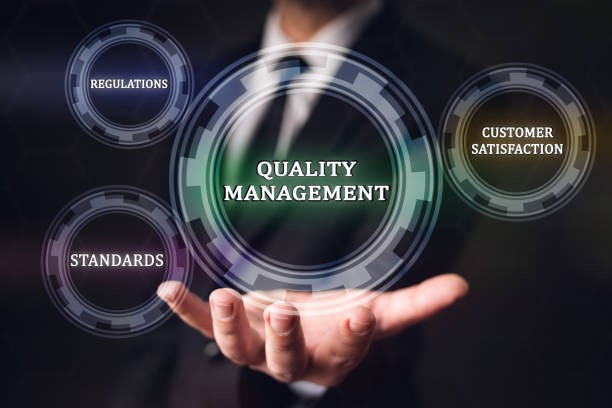
 Data Structure
Data Structure Networking
Networking RDBMS
RDBMS Operating System
Operating System Java
Java MS Excel
MS Excel iOS
iOS HTML
HTML CSS
CSS Android
Android Python
Python C Programming
C Programming C++
C++ C#
C# MongoDB
MongoDB MySQL
MySQL Javascript
Javascript PHP
PHP
- Selected Reading
- UPSC IAS Exams Notes
- Developer's Best Practices
- Questions and Answers
- Effective Resume Writing
- HR Interview Questions
- Computer Glossary
- Who is Who
Quality Management in the Real World
The degree of excellence determines the ?Quality.' so, when we are talking about the quality product or service, we deliberately mean the degree of excellence that meets the customer's expectations. Thus, quality management rules the business world. And an organization's success and failure depend on the parameters of excellence. So let's learn more about it in our today's post.
What is Quality Management?

Quality management is the process of achieving a set of standards that are based on customers' demands and choices. It is an act that ensures the smooth processing of products and service delivery and achieves the target goals of the business. Thus, quality management helps an organization set its purpose and serve the customers with utmost satisfaction.
Four prime components of Quality management include:
Quality Planning - Planning identifies the standard of the project and prepares the blueprint for achieving them.
Quality Control - Control integrates inner strength and reliability while achieving the company's goals.
Quality Improvement - Improvement leads to modifying the process to get a better outcome.
Quality Assurance - Assurance optimizes and ensures the necessary action is taken to meet the specific requirements to complete the project.
The prime target of quality management is to gather the stakeholders to work together to achieve the organization's products, services, culture, and long-term success.
The Guidelines of Quality Management
The quality management process ensures the improvement of the products or services that are delivered to the customers and meet their expectations.
The guidelines include the below keynotes -
Clear Target: When the process starts, its primary base is to determine the precise target. And all organizations have their specific target
Determine the Actions: Once the company sets the target, the next move will be planning how to achieve the target. In this step, the company should focus on quality measures making room for improvement and taking immediate action if quality issues arise.
Achieve the target: The final stage involves reporting on the overall development and the quality achieved.
The Benefits of the Quality Management
Quality management has the prime control to take the company to a higher level by increasing revenue building a solid customer base and increasing sales. Thus, it has a few significant benefits that help the organization sustain itself in the market, produce quality products or services, and satisfy customers' needs. The benefits include -
Quality management helps achieve the target with consistent delivery of the products and services and successfully creates its customer base.
It enhances the customer satisfaction level.
It helps reduce waste and build a solid foundation to utilize time and resources better.
It helps to enhance business integrity by employing resources and managing business growth effectively.
It encourages and is involved in producing better products or services with an integrated system.
It helps enhance the market and the business, and stay ahead of the competition.
Therefore, quality management contributes to the organization's growth and helps stay consistent, and enlarges the scope of improvisation of the product or service as per the market's need.
The Prime 7 Golden Principles of Quality Management of the Real World

Quality management, however, is based on certain principles that enable an organization's adaptability and influence the success ratio in the real world. Let's learn the primary principles of quality management -
Customer Focus
The fundamental focus of an organization must be the customer. Customer satisfaction should be the main target of any small, medium, or large company. Once the organization sense the pulse of the need of the customers and design the plan to win them, it completes the half job done. In return, it will receive loyal customers and good business. Further, customer orientation helps grab new customers and expand its business horizons.
Leadership Approach
A good leader with visions can expand the company a long way. Therefore, the leadership approach is necessary to lead the team, make the decision, and have the power to sense upcoming challenges and prepare backup plans. Thus, leaders guide the employees and help them understand the organization's goals, perspective, mission, and vision. In addition, employees are motivated to improve their skills and loyalty to their productive outcomes.
Engagement of Resources
Quality management only works out if the organization can utilize the potential resources and helps the company to build its strong foundation, produce quality products or services and expand its markets. In this process, organizations are free to take help from full-time and part-time employees or outsource the tasks. However, utilizing the resources indicates that the organization motivates its resources to improve its skills and show consistent results in the ground reality.
Further, the organization must empower its resources by encouraging them in decision-making, celebrating the achievement, and offering various perks and increments for their tireless contribution to the company's growth.
Process Approach
An organization's process approach is based on its internal functions and how effectively the organization achieves its target. In the process approach, improvised consistency, fast and practical activities, cost reduction, waste removal and management, and continued focus on growth are crucial for any organizational sustain policy.
Further, the process approach focuses on managing input and output and helps increase the growth ratio.
Consistency in Improvement
Improvement implies its basic rules, which include focusing on performance, improving performance and growth, adapting flexible functions, and enhancing the ability to create new opportunities. The improvement is set to the company's objective and encourages all to participate in the growth process actively.
Decision-Making in Reality Ground
Verified and analyzed data are the two terms that help in decision-making. Significantly when the market changes, the organization makes a firm decision based on tried and tested data. Further, it helps to understand the results and consequences of the operation.
Relationship Management
Relationship management is the key to creating a successful and healthy bond between suppliers and retailers. A successful relationship with suppliers can create sustainability that leads organizations in the long run. This is why communication with interested suppliers and retailers strengthens the business aspects. The organization should optimize and create a flexible policy to ease relationship management and fast growth with strong collaboration.
These seven principles are the golden Key points to running an organization successfully.
Summary
Quality management is the base of any successful business. The seven golden rules, therefore, control the entire process and helps an organization to sustain and secure its establishment amid neck-to-neck competition. Further, it helps in the expansion of business in the real world and creates opportunities for the continued growth process.

